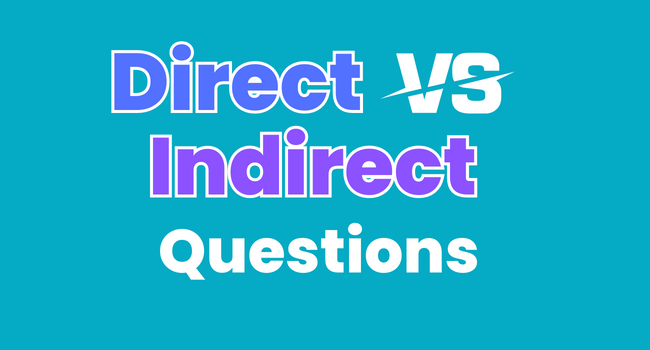
In today’s lesson, we are going to talk about direct vs indirect questions. Direct questions always end with a question mark. Indirect questions may end with a question mark or a period, depending on the type of question.
What are Direct Questions?
A direct question is a straightforward question that seeks a specific answer. Direct questions always end in question marks. Direct questions often begin with a question word: who, what, where, when, why, or how.
Examples:
- Where are you?
- Who is your best friend?
- What do you want for dinner?
- What time is it?
- How are you?
These are direct questions. They seek specific answers.
Direct questions may also begin with a helping verb or auxiliary verb + a subject.
Examples:
- Are you upset?
- Were you busy?
- Is she hungry?
- Do you like coffee?
- Did they break up?
- Have you been to Italy?
In all of these examples, we have the helping verb or auxiliary verb + the subject. These are all direct questions that seek specific answers, and they all end in question marks.
What are Indirect Questions?
An indirect question is a question embedded within a statement or a more complex sentence structure. It often expresses a polite request or a desire for information. Indirect questions may end in periods or question marks.
Let’s look at some examples of indirect questions that end in periods and not question marks.
Examples:
- I wonder if that handsome man is single.
- Please check if the store is open on Sundays.
- I want to know where the art museum is.
In all of these examples, we are expressing a desire to know something. However, we are not directly asking a question.
Some indirect questions end in question marks. Indirect questions are a way of being polite. They are very common in English, especially when you’re talking to someone you don’t know or you’re talking to someone in a position of authority.
If we were to turn these indirect questions into direct questions, we would say:
- Is that handsome man single?
- Is the store open on Sundays?
- Where is the art museum?
Let’s review some indirect questions that end in question marks. “Could you tell me where Park Avenue is?” is an indirect question. It’s a question within a question. My real question is, “Where is Park Avenue?”
More examples of indirect questions ending in question marks:
- Do you know if Emily is invited to the party? (indirect question)
- Is Emily invited to the party? (direct question)
- Would you mind telling me if there is a supermarket nearby? (indirect question)
- Is there a supermarket nearby? (direct question)
- Can you tell me what time the post office closes? (indirect question)
- What time does the post office close? (direct question)
Quiz: Direct or Indirect?
Now, let’s do a quiz, and you have to determine if each one is a direct question or an indirect question. Remember that direct questions require direct answers. They often begin with question words like who, what, when, where, why, or how, or an auxiliary verb + a subject. Indirect questions are a more polite way of asking a question and oftentimes are phrased like a request.
- When is your English exam?
- Did Gerald get the promotion he wanted?
- Do you know if it’s going to rain tomorrow?
- What time does the movie start?
- I wonder when Dad will get home from work.
- Have you ever been to Italy?
- Could you tell me where to find the nearest supermarket?
- Will you come to the shoe store with me?
- I don’t know why he is speaking to you like that.
- Would you mind telling me what time the concert starts?
You can find the answers to this quiz by watching by YouTube video on Direct VS Indirect Questions above! What did you score out of 10?

Leave a Reply